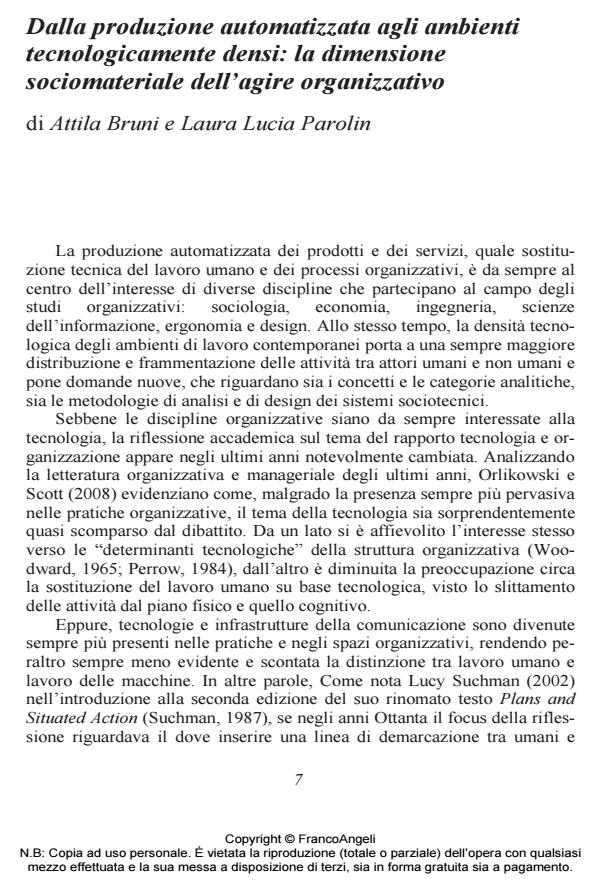Dalla produzione automatizzata agli ambienti tecnologicamente densi: la dimensione sociomateriale dell’agire organizzativo
Titolo Rivista STUDI ORGANIZZATIVI
Autori/Curatori Attila Bruni, Laura Lucia Parolin
Anno di pubblicazione 2014 Fascicolo 2014/1
Lingua Italiano Numero pagine 20 P. 7-26 Dimensione file 98 KB
DOI 10.3280/SO2014-001001
Il DOI è il codice a barre della proprietà intellettuale: per saperne di più
clicca qui

FrancoAngeli è membro della Publishers International Linking Association, Inc (PILA)associazione indipendente e non profit per facilitare (attraverso i servizi tecnologici implementati da CrossRef.org) l’accesso degli studiosi ai contenuti digitali nelle pubblicazioni professionali e scientifiche
The relationship between work processes and technological innovations is a recurring theme of all the disciplines interested in organizational analysis. The majority of the studies focus on the introduction on new technologies to evaluate the effects of work organization while less common are the analysis of long term effects and of the stratification of technical artefacts that, over time, lead to the creation of Technologically Dense Environments. This work addresses these issues through an empirical analysis of “junction work”, the array of apparently marginal activities performed by human actors to allow information systems to be aligned. The interest in junction work stems from its being considered a undesired by-product of innovation. Junction work takes the form of copying hand notes, transcribing data from one system to another (digital or paper-based), data inputting and so on. We present the case of information management in an oncological department ten years after the deployment of an electronic medical record and is based on qualitative interviews and participant observation aimed at discovering the origin of junction work, its analysis and the changes in the professional profile of the people that perform it. Results show that innovation process, guided by medical doctors, is intertwined with a delegation to nurses of a growing role as information managers. The overall outcome is the transformation of the ward into a technologically dense environments in the nurses experience, required to perform a constant junction work to ensure the information flow within the department and with the rest of the other facilities. Results therefore confirm how the cumulative effects of technological stratification have a different impact on organizational actors. Despite being represented as transient and accidental, junction work appears a constitutive element of technologically dense environments and it can therefore be considered as a useful unit of analysis to study them.
Parole chiave:Technologically dense environments, junction work, nursing, information systems
- Tecnologie digitali e potere nelle organizzazioni: dinamiche di controllo ed effetto "contraccolpo" Lia Tirabeni, Francesco Miele, in STUDI ORGANIZZATIVI 1/2020 pp.9
DOI: 10.3280/SO2020-001001 - Perceived autonomy and discretion of mobile workers Roberto Albano, Ylenia Curzi, Tania Parisi, Lia Tirabeni, in STUDI ORGANIZZATIVI 2/2019 pp.31
DOI: 10.3280/SO2018-002002 - Real and apparent changes of organizational processes in the era of big data analytics Marcello Martinez, Primiano Di Nauta, Debora Sarno, in STUDI ORGANIZZATIVI 2/2018 pp.91
DOI: 10.3280/SO2017-002005 - Assessing the technological maturity of small enterprises through a collaborative approach Andrea Tomo, in STUDI ORGANIZZATIVI 2/2019 pp.147
DOI: 10.3280/SO2018-002007 - Coltivare creatività pratica e pensiero critico in Higher Education. Elementi di analisi per una geografia concettuale Francesca Bracci, Monica Fedeli, in EXCELLENCE AND INNOVATION IN LEARNING AND TEACHING 1/2023 pp.38
DOI: 10.3280/exioa1-2023oa16040 - Connectivity and human capacity in digital transformation: the exploratory hypotheses of hyper industrial Emiliana Armano, Salvatore Cominu, Kristin Carls, Marco Briziarelli, in STUDI ORGANIZZATIVI 1/2021 pp.146
DOI: 10.3280/SO2021-001007 - Rethinking Work: Pathways and Practices in Business and Society. Introduction to the Special Issue. Luigi Moschera, Mario Pezzillo Iacono, Giovanna Lo Nigro, Laura Lucia Parolin, in STUDI ORGANIZZATIVI 2/2019 pp.9
DOI: 10.3280/SO2018-002001
Attila Bruni, Laura Lucia Parolin, Dalla produzione automatizzata agli ambienti tecnologicamente densi: la dimensione sociomateriale dell’agire organizzativo in "STUDI ORGANIZZATIVI " 1/2014, pp 7-26, DOI: 10.3280/SO2014-001001